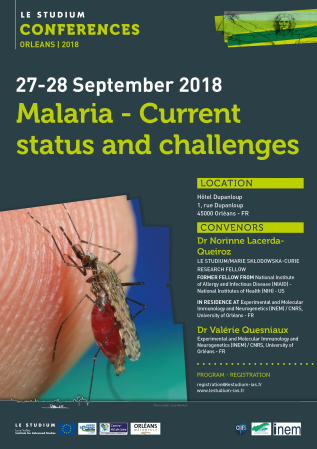Dr Norinne Lacerda-Queiroz

Établissement d'origine
National Institute of Allergy and Infectious Disease (NIAID) – NIH, Rockville - US
Laboratoire d'accueil
Hôte Scientifique
Dr Valérie Quesniaux
PROJET
Étude de dommages pulmonaires lors de malaria sévère expérimentale : syndrome de détresse respiratoire aiguë associée à la malaria (MA-ARDS) et syndrome septique induit par infection bactérienne secondaire
Les parasites du genre Plasmodium infectent chaque année des centaines de millions de personnes et des complications causent la mort d’un demi million d’entre elles. Les manifestations de la malaria dite sévère incluent la malaria cérébrale, le syndrome de détresse respiratoire aiguë (ARDS) et l’anémie sévère. Le modèle souris de malaria cérébrale, où l’infection est induite par P. berghei ANKA, est adéquat pour l’étude de certains paramètres de la malaria cérébrale mais, en raison de la mort rapide des animaux infectés, restent d’un intérêt très limité quant à l’étude d’autres manifestations de la malaria sévère.
Nous proposons d’étudier l’impact de deux complications majeures, souvent fatales bien que peu étudiées : le syndrome de détresse respiratoire aiguë associée à la malaria (MA-ARDS) et le syndrome septique induit par une infection bactérienne secondaire.Dans une première partie, nous caractériserons les interactions leucocytes-cellules endothéliales suite à l’infection de souris C57BL/6 par P. berghei NK65. Notre hypothèse est que les lymphocytes T CD8+ ont un rôle pathogénique dans le poumon en raison de leur expression de molécules d’adhésion à l’endothélium et la production de granzyme. Dans une seconde partie, nous étudierons les mécanismes d’hypersensibilité à l’infection bactérienne chez les souris infectées par Plasmodium. Sachant que les chocs septiques sont associés à l’ARDS, nous évaluerons les dommages pulmonaires présents dans différents modèles de sepsis et de co-infections, en particulier le rôle de l’hème et de la mort cellulaire associée.
En résumé, ce projet est basé sur l’étude du rôle encore mécompris des syndromes pulmonaires lors de la malaria. Une meilleure compréhension de la complexité et de la diversité des complications est essentielle afin de développer de nouvelles approches thérapeutiques.
Publications
Cigarette smoke exposure is a leading cause of chronic obstructive pulmonary disease (COPD), a major health issue characterized by airway inflammation with fibrosis and emphysema. Here we demonstrate that acute exposure to cigarette smoke causes respiratory barrier damage with the release of self-dsDNA in mice. This triggers the DNA sensor cGAS (cyclic GMP-AMP synthase) and stimulator of interferon genes (STING), driving type I interferon (IFN I) dependent lung inflammation, which are attenuated in cGAS, STING or type I interferon receptor (IFNAR) deficient mice. Therefore, we demonstrate a critical role of self-dsDNA release and of the cGAS-STING-type I interferon pathway upon cigarette smoke-induced damage, which may lead to therapeutic targets in COPD.
Final reports
Malaria is one of the most important parasitic infection in the world. Cerebral and pulmonary complications may occur after infection and are often lethal. Immune response plays an important role in controlling malaria infection; however, excessive inflammatory response can lead to severe disease. The present work aims to decipher the cellular and molecular events associated with brain and pulmonary pathology in response to blood stage Plasmodium berghei ANKA (PbA) infection. PbA infection in C57BL/6 wild-type (WT) mice induces experimental cerebral malaria (ECM), associated with strong pro-inflammatory response, brain damage, as well as paralysis, coma early death (around day 7 p.i.). Interestingly, IFNγ receptor deficient mice (IFNγR1-/-, C57BL/6 background) are resistant to ECM and died at a later time-point, due to the hyperparasitaemia and severe anemia. Here, we addressed the impact of IFNγR1 deficiency in the development of pulmonary damage during PbA infection. At day 7 post-infection, the broncho-alveolar lavage (BAL) allowed the quantitative analysis of total cells and proteins in the broncho-alveolar space of the animals. In addition, histological analysis and Western blot were performed to compare the cerebral and pulmonary compartments. As compared to PbA-infected WT mice, the histological sections confirmed a less intense accumulation of leukocytes as well as an absence of hemorrhages in the brains of IFNγR1-/- mice. In addition, the quantification of pro-apoptotic proteins (Granzyme B and cleaved caspase-3) in olfactory bulbs showed lower levels in IFNγR1-/- mice. While IFNγR1 deficient mice were fully resistant to brain pathology, those mice were partially protected for pulmonary damage, as observed by the levels of Granzyme B and cleaved caspase-3 in the lung parenchyma, leukocyte number in the broncho-alveolar space and pulmonary edema.



